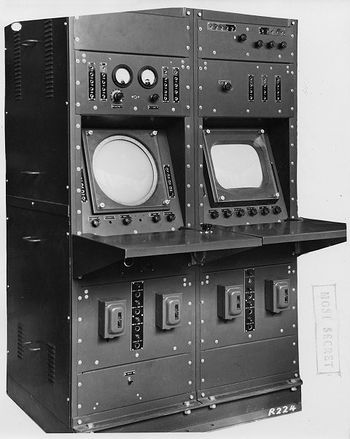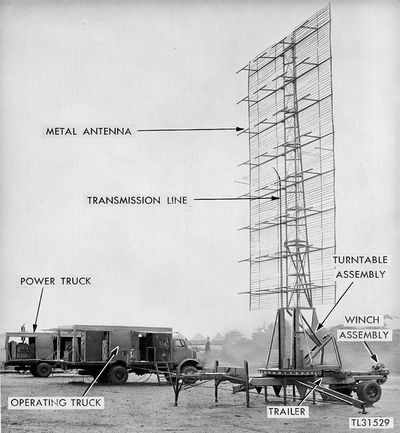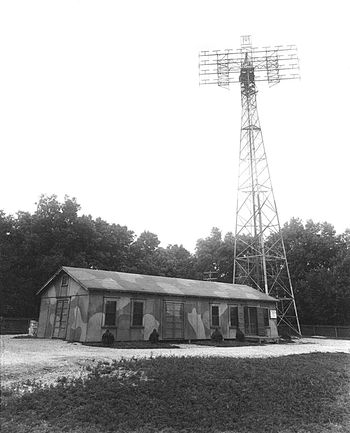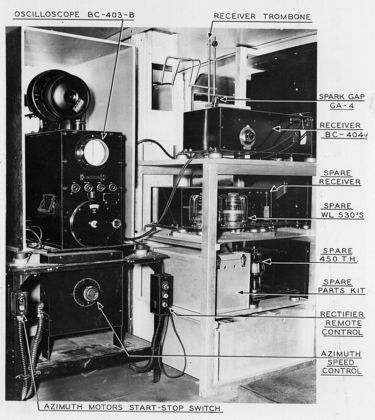SCR-270
|
SCR-270 Long Range Search Radar Set - A World War II Long Range Search Radar set built by Westinghouse/Western Electric for the US Army Signal Corps. Introduced in 1940 and was operationally deployed starting in 1940 before the US entered World War II.
SCR-270 Search RadarDevelopmentDeveloped by Westinghouse/Western Electric for the US Army Signal Corps. DeploymentIntroduced in 1940 and was operationally deployed starting in 1940 before the US entered World War II. Among the first deployments were sets sent to the Canal Zone (1940) and to Hawaii (1941). Six SCR-270 radar sets were in place at Hawaii on 7 Dec 1941 when the Japanese attacked Pearl Harbor. One set on the northern tip of Oahu at Opana Station spotted the attacking aircraft at 0702 as a large bloom on the radar at 132 miles out. Opana station was normally shut down during the daylight hours to conserve scarce vacuum tubes but remained operation that morning for additional training. At 0720 they reported the large approaching radar bloom to the information center at Fort Shafter but their information was not acted on and the attack commenced at 0800.  By the end of 1941, some 100 sets had been delivered and by the end of production in 1944 almost 800 sets had been produced. ConfigurationsOf the two major versions, the mobile version SCR-270 was the most used because it could be packed up and easily moved to new locations when conditions dictated. The complete set was carried in 4 to 6 vehicles, the largest measuring 30'4" x 9'10" x 8'. Total weight of shipment was 101,790 lbs; total volume 11,485 cu. ft. The mobile radar set could be operated from the transport trucks or could be removed and placed in a fixed facility. The truck-mounted configuration could be in operation about 6 hours after arrival. Site requirements included a height between 100' and 1000' above an unobstructed flat surface. The set could be operated by a seven-man operating crew. For 24 hour operation, about 50 men were required to run radar, communications, and the associated camp. Electrical power was furnished by a PE-74, 25 KVA gasoline-driven generator set. SCR-271The SCR-271 fixed Radar set came packed in 106 units, weighing a total of 42,279 lbs. The largest unit was 176″ x 25″ x 20″. Installation required a weatherproof building approximately 20′ x 40′ for housing radar components and a building approx. 20′ x 20′ for housing the power units and switchboard. A 100-foot tower on concrete footings was required for an SCR-271D and a 50-ft. tower for an SCR-271-3. Buildings and tower were built by engineers in about 3 weeks. The Radar could be installed by five men in about two weeks. EvolutionThe SCR-270 evolved during the war from a relatively crude set with a single small 5-inch "A" scope display in the beginning to a rather substantial pair of 12-inch displays housed in a large cabinet. The larger displays provided a 12-inch "A" scope display and a 12-inch plan position indicator (PPI) display, the traditional centered, rotating range/azimuth display. The antenna changed over time from a vertical flat array of dipole antennas 4 dipoles wide by 9 dipoles high to a more sensitive horizontal array of dipole antennas 8 wide by 4 high. The noise figure improved from 12 db to 6db, improving range and sensitivity. Modifications were required to the antenna when the PPI scope was added to synchronize the two. The changes over the course of the war can provide a great disparity in photographs of SCR-270/271 sites, for example, compare the early mobile version pictured above with a later SCR-271 fixed-site above. Interior shots can also be vastly different. Compare the operating position of an early SCR-270 above with the twin 12" displays of later models above.
See Also: Sources:
Links:
| ||||||||||||||||||||||||||||||||||||||||||||||||||||||||||||||||||||||||||||||||||||||||||||||||||||||||||||||||||||


